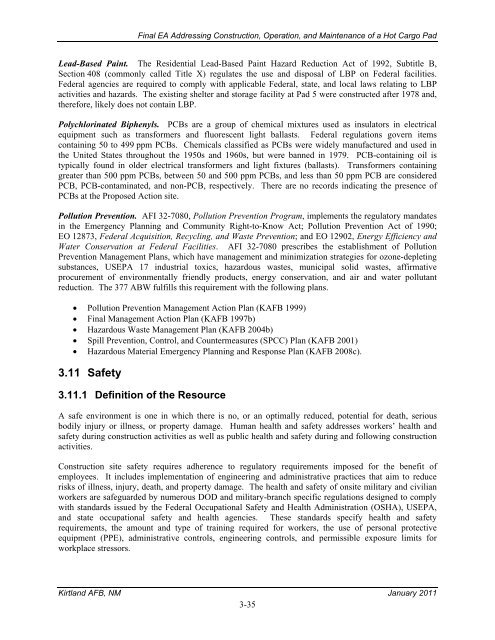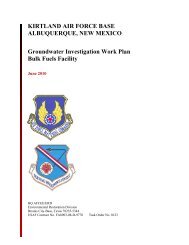Final FONSI and EA for hot cargo pad on Kirtland AFB - Kirtland Air ...
Final FONSI and EA for hot cargo pad on Kirtland AFB - Kirtland Air ...
Final FONSI and EA for hot cargo pad on Kirtland AFB - Kirtland Air ...
Create successful ePaper yourself
Turn your PDF publications into a flip-book with our unique Google optimized e-Paper software.
<str<strong>on</strong>g>Final</str<strong>on</strong>g> <str<strong>on</strong>g>EA</str<strong>on</strong>g> Addressing C<strong>on</strong>structi<strong>on</strong>, Operati<strong>on</strong>, <str<strong>on</strong>g>and</str<strong>on</strong>g> Maintenance of a Hot Cargo Pad<br />
Lead-Based Paint. The Residential Lead-Based Paint Hazard Reducti<strong>on</strong> Act of 1992, Subtitle B,<br />
Secti<strong>on</strong> 408 (comm<strong>on</strong>ly called Title X) regulates the use <str<strong>on</strong>g>and</str<strong>on</strong>g> disposal of LBP <strong>on</strong> Federal facilities.<br />
Federal agencies are required to comply with applicable Federal, state, <str<strong>on</strong>g>and</str<strong>on</strong>g> local laws relating to LBP<br />
activities <str<strong>on</strong>g>and</str<strong>on</strong>g> hazards. The existing shelter <str<strong>on</strong>g>and</str<strong>on</strong>g> storage facility at Pad 5 were c<strong>on</strong>structed after 1978 <str<strong>on</strong>g>and</str<strong>on</strong>g>,<br />
there<str<strong>on</strong>g>for</str<strong>on</strong>g>e, likely does not c<strong>on</strong>tain LBP.<br />
Polychlorinated Biphenyls. PCBs are a group of chemical mixtures used as insulators in electrical<br />
equipment such as trans<str<strong>on</strong>g>for</str<strong>on</strong>g>mers <str<strong>on</strong>g>and</str<strong>on</strong>g> fluorescent light ballasts. Federal regulati<strong>on</strong>s govern items<br />
c<strong>on</strong>taining 50 to 499 ppm PCBs. Chemicals classified as PCBs were widely manufactured <str<strong>on</strong>g>and</str<strong>on</strong>g> used in<br />
the United States throughout the 1950s <str<strong>on</strong>g>and</str<strong>on</strong>g> 1960s, but were banned in 1979. PCB-c<strong>on</strong>taining oil is<br />
typically found in older electrical trans<str<strong>on</strong>g>for</str<strong>on</strong>g>mers <str<strong>on</strong>g>and</str<strong>on</strong>g> light fixtures (ballasts). Trans<str<strong>on</strong>g>for</str<strong>on</strong>g>mers c<strong>on</strong>taining<br />
greater than 500 ppm PCBs, between 50 <str<strong>on</strong>g>and</str<strong>on</strong>g> 500 ppm PCBs, <str<strong>on</strong>g>and</str<strong>on</strong>g> less than 50 ppm PCB are c<strong>on</strong>sidered<br />
PCB, PCB-c<strong>on</strong>taminated, <str<strong>on</strong>g>and</str<strong>on</strong>g> n<strong>on</strong>-PCB, respectively. There are no records indicating the presence of<br />
PCBs at the Proposed Acti<strong>on</strong> site.<br />
Polluti<strong>on</strong> Preventi<strong>on</strong>. AFI 32-7080, Polluti<strong>on</strong> Preventi<strong>on</strong> Program, implements the regulatory m<str<strong>on</strong>g>and</str<strong>on</strong>g>ates<br />
in the Emergency Planning <str<strong>on</strong>g>and</str<strong>on</strong>g> Community Right-to-Know Act; Polluti<strong>on</strong> Preventi<strong>on</strong> Act of 1990;<br />
EO 12873, Federal Acquisiti<strong>on</strong>, Recycling, <str<strong>on</strong>g>and</str<strong>on</strong>g> Waste Preventi<strong>on</strong>; <str<strong>on</strong>g>and</str<strong>on</strong>g> EO 12902, Energy Efficiency <str<strong>on</strong>g>and</str<strong>on</strong>g><br />
Water C<strong>on</strong>servati<strong>on</strong> at Federal Facilities. AFI 32-7080 prescribes the establishment of Polluti<strong>on</strong><br />
Preventi<strong>on</strong> Management Plans, which have management <str<strong>on</strong>g>and</str<strong>on</strong>g> minimizati<strong>on</strong> strategies <str<strong>on</strong>g>for</str<strong>on</strong>g> oz<strong>on</strong>e-depleting<br />
substances, USEPA 17 industrial toxics, hazardous wastes, municipal solid wastes, affirmative<br />
procurement of envir<strong>on</strong>mentally friendly products, energy c<strong>on</strong>servati<strong>on</strong>, <str<strong>on</strong>g>and</str<strong>on</strong>g> air <str<strong>on</strong>g>and</str<strong>on</strong>g> water pollutant<br />
reducti<strong>on</strong>. The 377 ABW fulfills this requirement with the following plans.<br />
Polluti<strong>on</strong> Preventi<strong>on</strong> Management Acti<strong>on</strong> Plan (K<strong>AFB</strong> 1999)<br />
<str<strong>on</strong>g>Final</str<strong>on</strong>g> Management Acti<strong>on</strong> Plan (K<strong>AFB</strong> 1997b)<br />
Hazardous Waste Management Plan (K<strong>AFB</strong> 2004b)<br />
Spill Preventi<strong>on</strong>, C<strong>on</strong>trol, <str<strong>on</strong>g>and</str<strong>on</strong>g> Countermeasures (SPCC) Plan (K<strong>AFB</strong> 2001)<br />
Hazardous Material Emergency Planning <str<strong>on</strong>g>and</str<strong>on</strong>g> Resp<strong>on</strong>se Plan (K<strong>AFB</strong> 2008c).<br />
3.11 Safety<br />
3.11.1 Definiti<strong>on</strong> of the Resource<br />
A safe envir<strong>on</strong>ment is <strong>on</strong>e in which there is no, or an optimally reduced, potential <str<strong>on</strong>g>for</str<strong>on</strong>g> death, serious<br />
bodily injury or illness, or property damage. Human health <str<strong>on</strong>g>and</str<strong>on</strong>g> safety addresses workers’ health <str<strong>on</strong>g>and</str<strong>on</strong>g><br />
safety during c<strong>on</strong>structi<strong>on</strong> activities as well as public health <str<strong>on</strong>g>and</str<strong>on</strong>g> safety during <str<strong>on</strong>g>and</str<strong>on</strong>g> following c<strong>on</strong>structi<strong>on</strong><br />
activities.<br />
C<strong>on</strong>structi<strong>on</strong> site safety requires adherence to regulatory requirements imposed <str<strong>on</strong>g>for</str<strong>on</strong>g> the benefit of<br />
employees. It includes implementati<strong>on</strong> of engineering <str<strong>on</strong>g>and</str<strong>on</strong>g> administrative practices that aim to reduce<br />
risks of illness, injury, death, <str<strong>on</strong>g>and</str<strong>on</strong>g> property damage. The health <str<strong>on</strong>g>and</str<strong>on</strong>g> safety of <strong>on</strong>site military <str<strong>on</strong>g>and</str<strong>on</strong>g> civilian<br />
workers are safeguarded by numerous DOD <str<strong>on</strong>g>and</str<strong>on</strong>g> military-branch specific regulati<strong>on</strong>s designed to comply<br />
with st<str<strong>on</strong>g>and</str<strong>on</strong>g>ards issued by the Federal Occupati<strong>on</strong>al Safety <str<strong>on</strong>g>and</str<strong>on</strong>g> Health Administrati<strong>on</strong> (OSHA), USEPA,<br />
<str<strong>on</strong>g>and</str<strong>on</strong>g> state occupati<strong>on</strong>al safety <str<strong>on</strong>g>and</str<strong>on</strong>g> health agencies. These st<str<strong>on</strong>g>and</str<strong>on</strong>g>ards specify health <str<strong>on</strong>g>and</str<strong>on</strong>g> safety<br />
requirements, the amount <str<strong>on</strong>g>and</str<strong>on</strong>g> type of training required <str<strong>on</strong>g>for</str<strong>on</strong>g> workers, the use of pers<strong>on</strong>al protective<br />
equipment (PPE), administrative c<strong>on</strong>trols, engineering c<strong>on</strong>trols, <str<strong>on</strong>g>and</str<strong>on</strong>g> permissible exposure limits <str<strong>on</strong>g>for</str<strong>on</strong>g><br />
workplace stressors.<br />
Kirtl<str<strong>on</strong>g>and</str<strong>on</strong>g> <strong>AFB</strong>, NM January 2011<br />
3-35
















